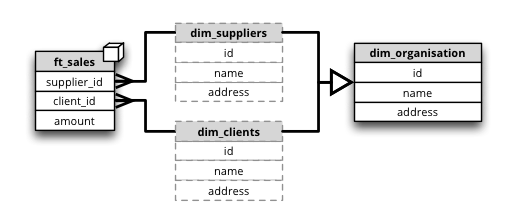Schemas and Models¶
This section contains example database schemas and their respective models with description. The examples are for the SQL backend. Please refer to the backend documentation of your choice for more information about non-SQL setups.
See also
- Logical Model and Metadata
- Logical model description.
- Backends
- Backend references.
- Model Reference
- Developer’s reference of model classes and fucntions.
Basic Schemas¶
Simple Star Schema¶
Synopsis: Fact table has the same name as the cube, dimension tables have same names as dimensions.
Fact table is called sales, has one measure amount and two dimensions: store and product. Each dimension has two attributes.
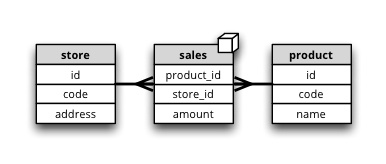
"cubes": [
{
"name": "sales",
"dimensions": ["product", "store"],
"joins": [
{"master":"product_id", "detail":"product.id"},
{"master":"store_id", "detail":"store.id"}
]
}
],
"dimensions": [
{ "name": "product", "attributes": ["code", "name"] },
{ "name": "store", "attributes": ["code", "address"] }
]
Simple Dimension¶
Synopsis: Dimension is represented only by one attribute, has no details, neither hierarchy.
Similar schema as Simple Star Schema Note the dimension year which is represented just by one numeroc attribute.
It is important that no attributes are specified for the dimension. There dimension will be referenced just by its name and dimension label is going to be used as attribute label as well.

"cubes": [
{
"name": "sales",
"dimensions": ["product", "store", "year"],
"joins": [
{"master":"product_id", "detail":"product.id"},
{"master":"store_id", "detail":"store.id"}
]
}
],
"dimensions": [
{ "name": "product", "attributes": ["code", "name"] },
{ "name": "store", "attributes": ["code", "address"] }
{ "name": "year" }
]
Table Prefix¶
Synopsis: dimension tables share a common prefix, fact tables share common prefix.
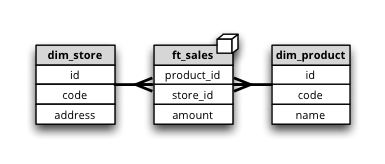
In our example the dimension tables have prefix dim_ as in dim_product or dim_store and facts have prefix fact_ as in fact_sales.
There is no need to change the model, only the data store configuration. In Python code we specify the prefix during the data store registration in cubes.Workspace.register_store():
workspace = Workspace()
workspace.register_store("default", "sql",
url=DATABASE_URL,
dimension_prefix="dim_",
dimension_suffix="_dim",
fact_suffix="_fact",
fact_prefix="fact_")
When using the OLAP Server we specify the prefixes in the [datastore] section of the slicer.ini configuration file:
[datastore]
...
dimension_prefix="dim_"
fact_prefix="fact_"
Not Default Database Schema¶
Synopsis: all tables are stored in one common schema that is other than default database schema.
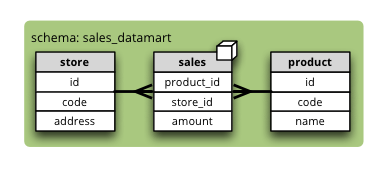
To specify database schema (in our example sales_datamart) in Python pass it in the schema argument of cubes.Workspace.register_store():
workspace = Workspace()
workspace.register_store("default", "sql",
url=DATABASE_URL,
schema="sales_datamart")
For the OLAP Server the schema is specifiedn in the [datastore] section of the slicer.ini configuration file:
[datastore]
...
schema="sales_datamart"
Separate Dimension Schema¶
Synopsis: dimension tables share one database schema and fact tables share another database schema

Dimensions can be stored in a different database schema than the fact table schema.
To specify database schema of dimensions (in our example dimensions) in Python pass it in the dimension_schema argument of cubes.Workspace.register_store():
workspace = Workspace()
workspace.register_store("default", "sql",
url=DATABASE_URL,
schema="facts",
dimension_schema="dimensions")
For the OLAP Server the dimension schema is specifiedn in the [datastore] section of the slicer.ini configuration file:
[datastore]
...
schema="facts"
dimension_schema="dimensions"
Mappings¶
Following patterns use the Explicit Mapping.
Basic Attribute Mapping¶
Synopsis: table column has different name than a dimension attribute or a measure.

In our example we have a flat dimension called year, but the physical table column is “sales_year”. In addition we have a measure amount however respective physical column is named total_amount.
We define the mappings within a cube:
"cubes": [
{
"dimensions": [..., "year"],
"measures": ["amount"],
"mappings": {
"year":"sales_year",
"amount":"total_amount"]
}
}
],
"dimensions": [
...
{ "name": "year" }
]
Hierarchies¶
Following patterns show how to specify one or multiple dimension hierarchies.
Simple Hierarchy¶
Synopsis: Dimension has more than one level.
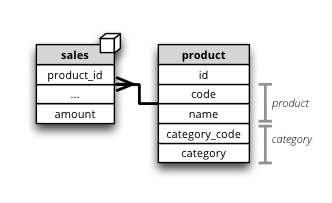
Product dimension has two levels: product category and product. The product category level is represented by two attributes category_code (as key) and category. The product has also two attributes: product_code and name.
"cubes": [
{
"dimensions": ["product", ...],
"measures": ["amount"],
"joins": [
{"master":"product_id", "detail":"product.id"}
]
}
],
"dimensions": [
{
"name": "product",
"levels": [
{
"name":"category",
"attributes": ["category_code", "category"]
},
{
"name":"product",
"attributes": ["code", "name"]
}
]
}
]
Multiple Hierarchies¶
Synopsis: Dimension has multiple ways how to organise levels into hierarchies.
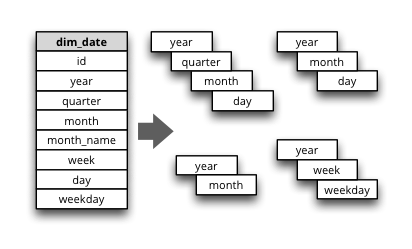
Dimensions such as date (depicted below) or geography might have multiple ways of organizing their attributes into a hierarchy. The date can be composed of year-month-day or year-quarter-month-day.
To define multiple hierarchies, first define all possible levels. Then create list of hierarchies where you specify order of levels for that particular hierarchy.
The code example below is in the “dimensions” section of the model:
{
"name":"date",
"levels": [
{ "name": "year", "attributes": ["year"] },
{ "name": "quarter", "attributes": ["quarter"] },
{ "name": "month", "attributes": ["month", "month_name"] },
{ "name": "week", "attributes": ["week"] },
{ "name": "weekday", "attributes": ["weekday"] },
{ "name": "day", "attributes": ["day"] }
],
"hierarchies": [
{"name": "ymd", "levels":["year", "month", "day"]},
{"name": "ym", "levels":["year", "month"]},
{"name": "yqmd", "levels":["year", "quarter", "month", "day"]},
{"name": "ywd", "levels":["year", "week", "weekday"]}
],
"default_hierarchy_name": "ymd"
}
The default_hierarchy_name specifies which hierarchy will be used if not mentioned explicitly.
User-oriented Metadata¶
Model Labels¶
Synopsis: Labels for parts of model that are to be displayed to the user

Labels are used in report tables as column headings or as filter descriptions. Attribute (and column) names should be used only for report creation and despite being readable and understandable, they should not be presented to the user in the raw form.
Labels can be specified for any model object (cube, dimension, level, attribute) with the label attribute:
"cubes": [
{
"name": "sales",
"label": "Product Sales",
"dimensions": ["product", ...]
}
],
"dimensions": [
{
"name": "product",
"label": "Product",
"attributes": [
{"name": "code", "label": "Code"},
{"name": "name", "label": "Product"},
{"name": "price", "label": "Unit Price"},
]
}
]
Key and Label Attribute¶
Synopsis: specify which attributes are going to be used for flitering (keys) and which are going to be displayed in the user interface (labels)
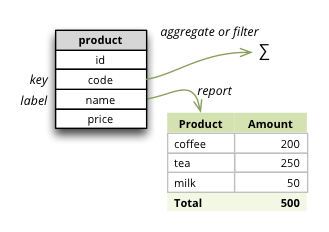
"dimensions": [
{
"name": "product",
"levels": [
{
"name": "product",
"attributes": ["code", "name", "price"]
"key": "code",
"label_attribute": "name"
}
]
}
]
Example use:
result = browser.aggregate(drilldown=["product"])
for row in result.table_rows("product"):
print "%s: %s" % (row.label, row.record["amount_sum"])
Localization¶
Localized Data¶
Synopsis: attributes might have values in multiple languages

Dimension attributes might have language-specific content. In cubes it can be achieved by providing one column per language (denormalized localization). The default column name should be the same as the localized attribute name with locale suffix, for example if the reported attribute is called name then the columns should be name_en for English localization and name_hu for Hungarian localization.
"dimensions": [
{
"name": "product",
"label": "Product",
"attributes": [
{"name": "code", "label": "Code"},
{
"name": "name",
"label": "Product",
"locales": ["en", "fr", "es"]
}
]
}
]
Use in Python:
browser = workspace.browser(cube, locale="fr")
The browser instance will now use only the French localization of attributes if available.
In slicer server requests language can be specified by the lang= parameter in the URL.
The dimension attributes are referred in the same way, regardless of localization. No change to reports is necessary when a new language is added.
Notes:
- only one locale per browser instance – either switch the locale or create another browser
- when non-existing locale is requested, then the default (first in the list of the localized attribute) locale is used
Localized Model Labels¶
Synopsis: Labels of model objects, such as dimensions, levels or attributes are localized.
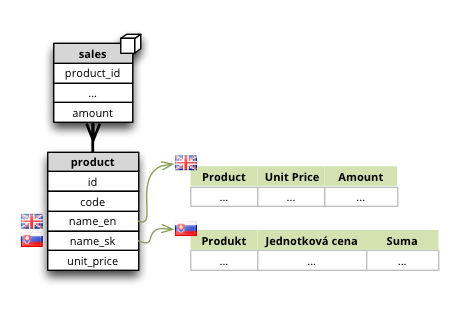
Note
Way how model is localized is not yet decided, the current implementation might be changed.
We have a reporting site that uses two languages: English and Slovak. We want all labels to be available in both of the languages. Also we have a product name that has to be localized.
First we define the model and specify that the default locale of the model is English (for this case). Note the locale property of the model, the label attributes and the locales of product.name attribute:
{
"locale": "en",
"cubes": [
{
"name": "sales",
"label": "Product Sales",
"dimensions": ["product"],
"measures": [
{"name": "amount", "label": "Amount"}
]
}
],
"dimensions": [
{
"name": "product",
"label": "Product",
"attributes": [
{
"name": "code",
"label": "Code"
},
{
"name": "name",
"label": "Product",
"locales": ["en", "sk"]
},
{
"name": "price",
"label": "Unit Price"
}
]
}
]
}
Next we create a separate translation dictionary for the other locale, in our case it is Slovak or sk. If we are translating only labels, no descriptions or any other information, we can use the simplified form:
{
"locale": "sk",
"dimensions":
{
"product”:
{
"levels":
{
"product" : "Produkt"
},
"attributes" :
{
"code": "Kód produktu",
"name": "Produkt",
"price": "Jednotková cena"
}
}
},
"cubes":
{
"sales":
{
"measures":
{
"amount": "Suma"
}
}
}
}
Full localization with detailed dictionaries looks like this:
{
"locale": "sk",
"dimensions":
{
"product”:
{
"levels":
{
"product" : { "label" : "Produkt"}
},
"attributes" :
{
"code": {"label": "Kód produktu"},
"name": {"label": "Produkt"},
"price": {"label": "Jednotková cena"}
}
}
},
"cubes":
{
"sales":
{
"measures":
{
"amount": {"label": "Suma"}
}
}
}
}
To create a model with translations:
translations = {"sk": "model-sk.json"}
model = create_model("model.json", translations)
The model created this way will be in the default locale. To get localized version of the master model:
localized_model = model.localize("sk")
Note
The cubes.Workspace.browser() method creates a browser with appropriate model localization, no explicit request for localization is needed.
See also
- cubes.load_model()
- Designated model loading function which accepts model translations.
- cubes.Model.localize()
- Get localized version of the model.
